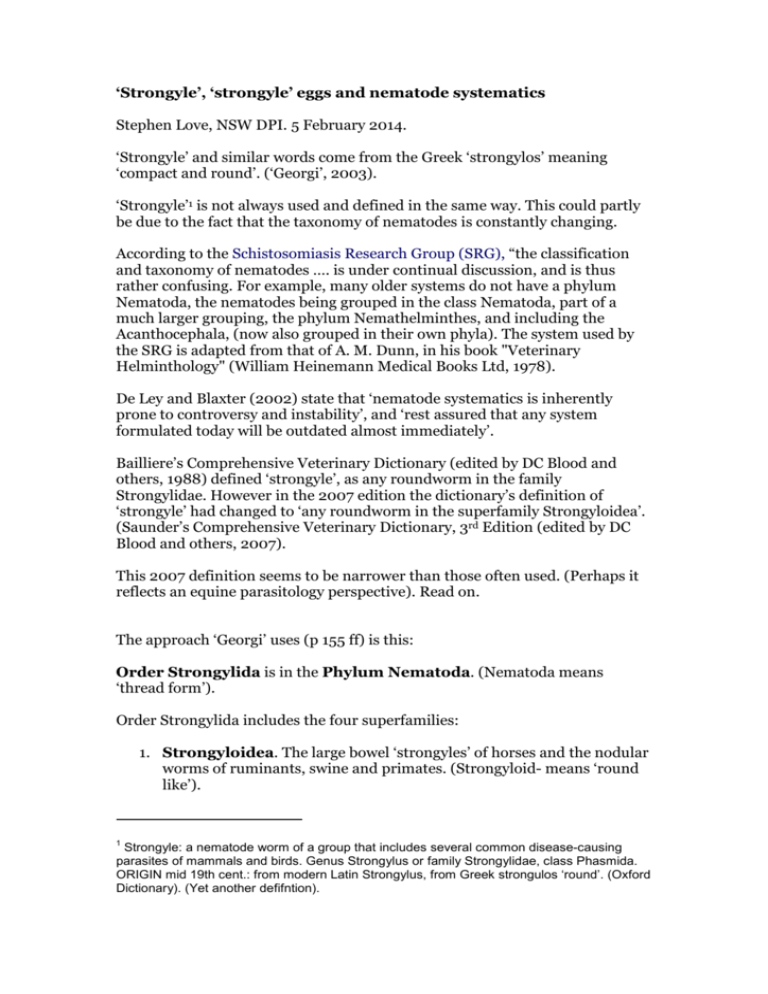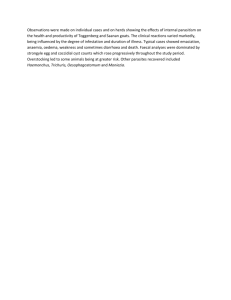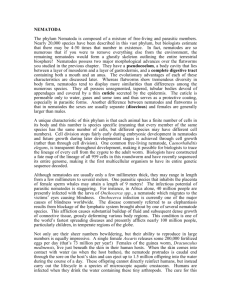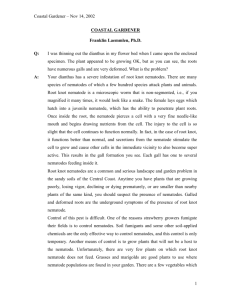Love S. Strongyle and Strongyle eggs
advertisement

‘Strongyle’, ‘strongyle’ eggs and nematode systematics Stephen Love, NSW DPI. 5 February 2014. ‘Strongyle’ and similar words come from the Greek ‘strongylos’ meaning ‘compact and round’. (‘Georgi’, 2003). ‘Strongyle’1 is not always used and defined in the same way. This could partly be due to the fact that the taxonomy of nematodes is constantly changing. According to the Schistosomiasis Research Group (SRG), “the classification and taxonomy of nematodes …. is under continual discussion, and is thus rather confusing. For example, many older systems do not have a phylum Nematoda, the nematodes being grouped in the class Nematoda, part of a much larger grouping, the phylum Nemathelminthes, and including the Acanthocephala, (now also grouped in their own phyla). The system used by the SRG is adapted from that of A. M. Dunn, in his book "Veterinary Helminthology" (William Heinemann Medical Books Ltd, 1978). De Ley and Blaxter (2002) state that ‘nematode systematics is inherently prone to controversy and instability’, and ‘rest assured that any system formulated today will be outdated almost immediately’. Bailliere’s Comprehensive Veterinary Dictionary (edited by DC Blood and others, 1988) defined ‘strongyle’, as any roundworm in the family Strongylidae. However in the 2007 edition the dictionary’s definition of ‘strongyle’ had changed to ‘any roundworm in the superfamily Strongyloidea’. (Saunder’s Comprehensive Veterinary Dictionary, 3rd Edition (edited by DC Blood and others, 2007). This 2007 definition seems to be narrower than those often used. (Perhaps it reflects an equine parasitology perspective). Read on. The approach ‘Georgi’ uses (p 155 ff) is this: Order Strongylida is in the Phylum Nematoda. (Nematoda means ‘thread form’). Order Strongylida includes the four superfamilies: 1. Strongyloidea. The large bowel ‘strongyles’ of horses and the nodular worms of ruminants, swine and primates. (Strongyloid- means ‘round like’). 1 Strongyle: a nematode worm of a group that includes several common disease-causing parasites of mammals and birds. Genus Strongylus or family Strongylidae, class Phasmida. ORIGIN mid 19th cent.: from modern Latin Strongylus, from Greek strongulos ‘round’. (Oxford Dictionary). (Yet another defifntion). 2. Trichostrongyloidea. The abomasal and small intestinal ‘hair worms’ of ruminants. (‘Trich-’ comes from the Greek for hair. So, Trichostrongylus is ‘hair round’). 3. Ancylostomatoidea. The ‘hookworms’ of diverse mammals. (Ancyclostoma means ‘curved mouth’). 4. Metastrongyloidea. The ‘lungworms’, although one of the most important lungworm genera, Dictyocaulus (‘net stalk’), falls within Trichostrongyloidea. Sutherland and Scott (2010), in their book on gastrointestinal nematodes of sheep and cattle, give a helpful overview to which non-experts in nematode systematics can relate. Some excerpts (paraphrased) from pages 1-2: Nematodes are now generally recognised as belonging to their own unique phylum, the Nematoda. They are quite biologically distinct from other ‘helminths’ such as the Platyhelminths (cestodes and trematodes) and Acanthocephala (the thorny headed worms). Indeed, because of nematode moulting behaviour, some consider them to be more closely related to other moulting organisms (which make up the superphylum, the Ecdysozoa) than to other helminth taxa, although there are strong arguments against this. However this might explain why drugs like ivermectin have excellent activity against nematodes and arthropods, but none against flukes or tapeworms. The major parasites of terrestrial vertebrates are split among the orders Ascaridia, Oxyurida, Rhabditida, Spirurida and the Strongylida (the strongylids). The strongylids include the vast majority of nematode gastrointestinal parasites causing disease in ruminants. There are several superfamilies in the order Strongylida, but most of the ruminant nematode parasites are in Trichostrongyloidea. The trichostrongylids are all slender, and tending to be small, with most around 20 mm long or less. They have small simple mouths and are mucosal browsers, feeding on small particles, mucus and dissolved molecules. There are a small number of important genera in other strongylid superfamilies such as Ancylostomatoidea (contains blood-sucking hookworms) and Strongyloidea (contains a number of ‘plug-feeders’, e.g. the strongyloids Oesophagostomum and Chabertia spp.). Members of these two superfamilies tend to be stouter than trichostrongyloids. Sutherland and Scott retain the older nomenclature/systematics (as above), because it is commonly used in the veterinary literature, but acknowledge that recent reviews (authors such as De Ley and Baxter, and Hodda) have challenged much of the older classification of nematode taxonomy, with a major change affecting the strongylid order. So, the order Strongylida could be ‘demoted’ to superfamily Strongyloidea, and the various superfamilies (Trichostrongyloidea etc) could be reduced to family level (Trichostrongylid, etc). Moving now to what ‘Georgi’ says about ‘the strongyle egg’ (page 299 in the 8th edition). The strongyle egg (closely following the text of ‘Georgi’): ‘Females of the superfamilies Strongyloidea, Trichostrongyloidea and Ancylostomatoidea lay thin-walled ellipsoidal eggs containing an embryo in the morula2 stage of development, and this same stage is found in the host’s faeces. ‘Georgi’ refers to these eggs as ‘strongyle’ because that is what most clinicians and diagnostic parasitologists call them. ‘The eggs of Metastrongyloidea are also thin-walled and ellipsoidal, but the developmental stage deposited in the host’s tissues by different species of female metastrongyloids varies from a single cell (e.g. Muellerius) to a first stage larva that is ready to hatch (e.g. Filaroides). Even those laid in the single-celled stage develop to the first stage and may have hatched by the time they appear in the faeces. Therefore the larvated eggs (e.g. Metastrongylus) or first-stage larvae are found in the faeces of hosts with patent metastrongyloid infections.’ (Where ‘Georgi’ uses expressions like ‘metastrongyloid’ or ‘trichostrongyloid’, others might use ‘metastrongyle’ or metastrongylid’, or trichostrongyle’, or ‘trichostrongylid’, presumably in part because they are using different taxonomic systems. Note that ‘-oid’ means ‘like’ or ‘similar to’. - SL) ‘With few exceptions, the generic identity of individual strongyle eggs cannot be established reliably by microscopic examination or micrometry. Nematodirus eggs stand out because of their large size and Bunostomum phlebotomum eggs have sticky surfaces which accumulate debris, but the rest look very much alike.’ (Apart from subtle size differences – SL). The way labs sometimes report faecal worm egg count results can unintentionally create confusion. For example the counts of eggs from genera such as Haemonchus, Trichostrongylus and Teladorsagia (these eggs are roughly 80 x 40 microns) may be reported in a column headed ‘strongyle’, with the result for Nematodirus eggs (roughly 190 x 90 microns) reported in a column headed ‘Nematodirus’, wrongly giving the impression that Nematodirus or its eggs are other than ‘strongyle’. 2 morula noun ( pl. morulae) Embryology a solid ball of cells resulting from division of a fertilized ovum, and from which a blastula is formed. ORIGIN mid 19th cent.: modern Latin, diminutive of Latin morum ‘mulberry’. blastula noun ( pl. blastulae or US blastulas ) Embryology an animal embryo at the early stage of development when it is a hollow ball of cells. ORIGIN late 19th cent.: modern Latin, from Greek blastos ‘sprout’. Oxford Dictionary. De Ley P and Blaxter M (2002). Systematic position and phylogeny, in ‘Biology of Nematodes’, edited by Donald L Lee. ISBN 0-415-27211-4. ‘Georgi’, 2003. Georgi’s Parasitology for Veterinarians, 8th edition. Edited by DW Bowman and others. Saunders, 2003. Schistosomiasis Research Group (SRG), Retrieved December 2013 from http://www.path.cam.ac.uk/~schisto/helminth_taxonomy/taxonomy_nemat oda.html Sutherland I and Scott I (2010).Gastrointestinal nematodes of sheep and cattle. Wiley-Blackwell. ISBN 978-1-4051-8582-0.







